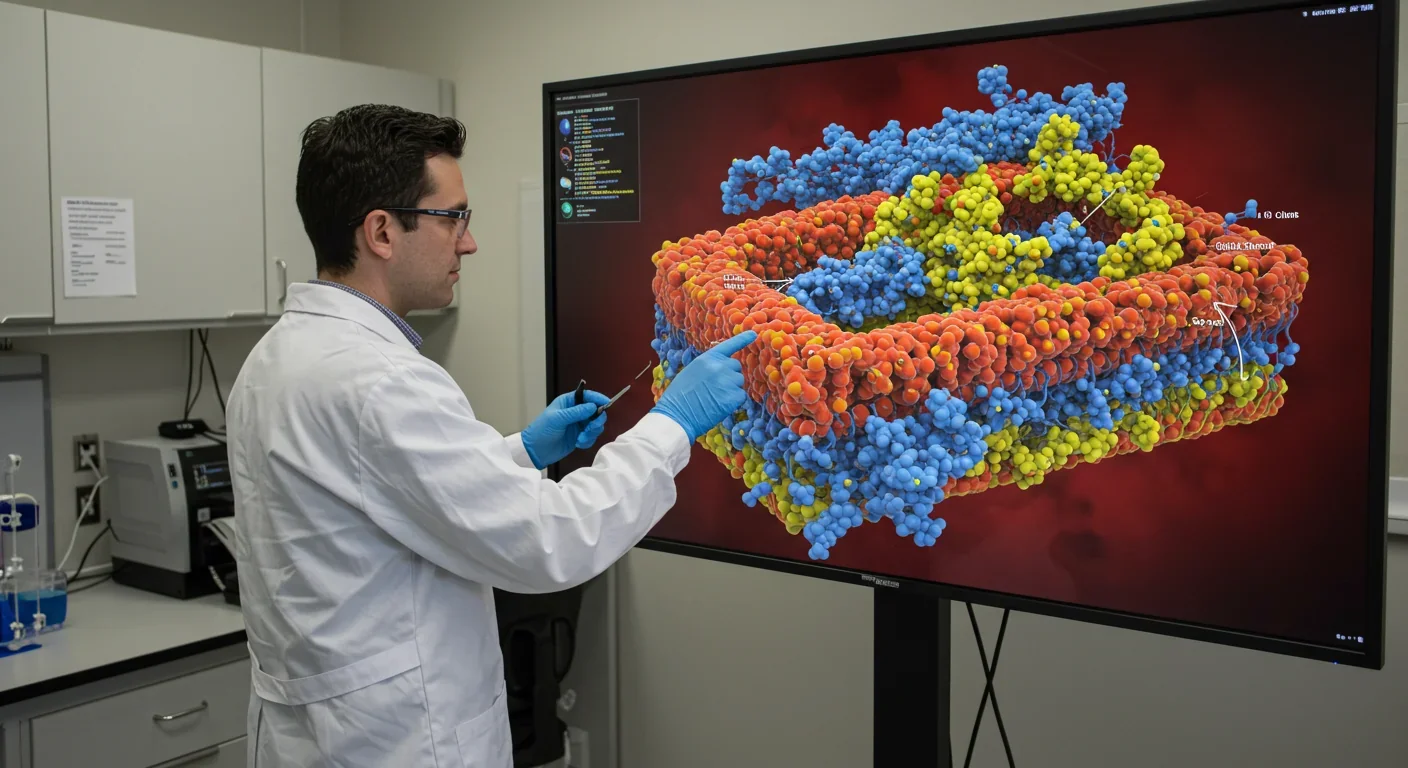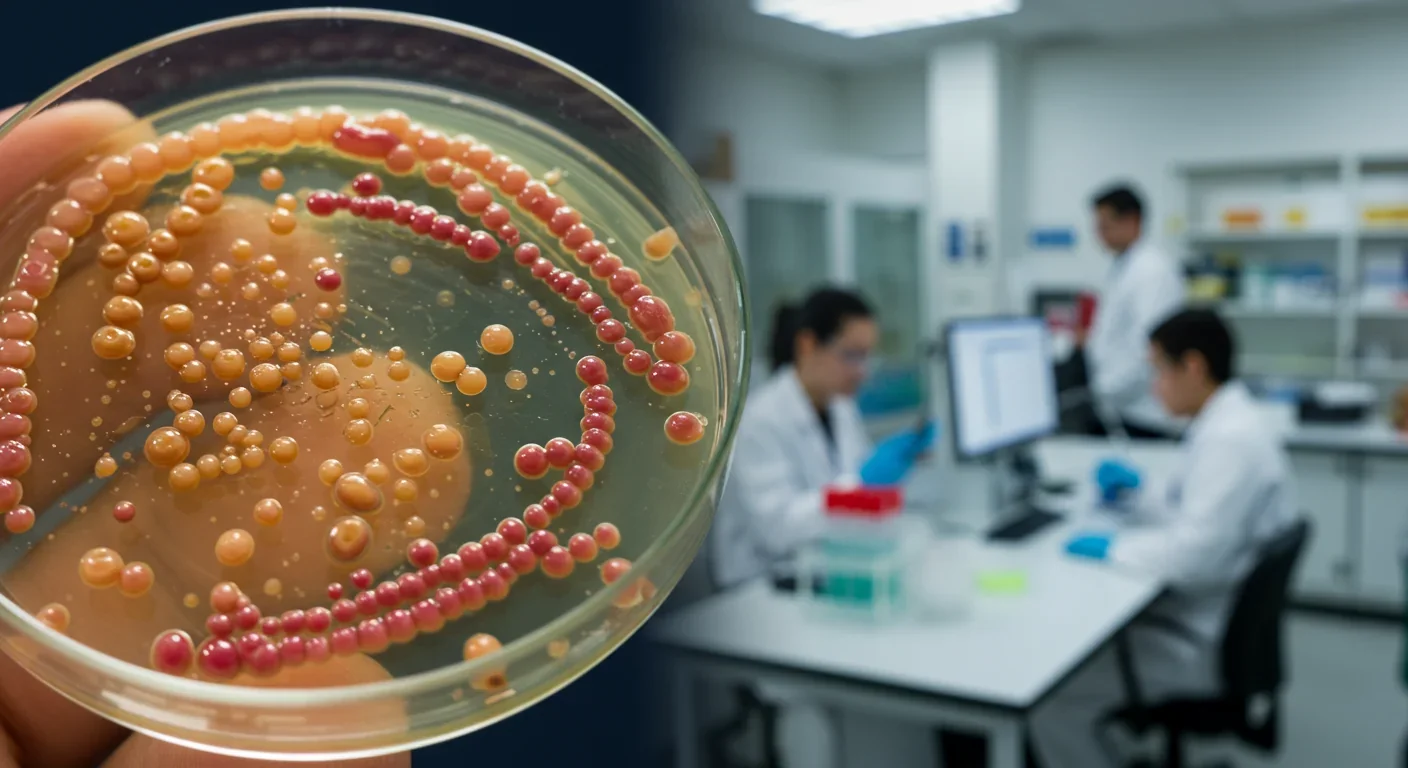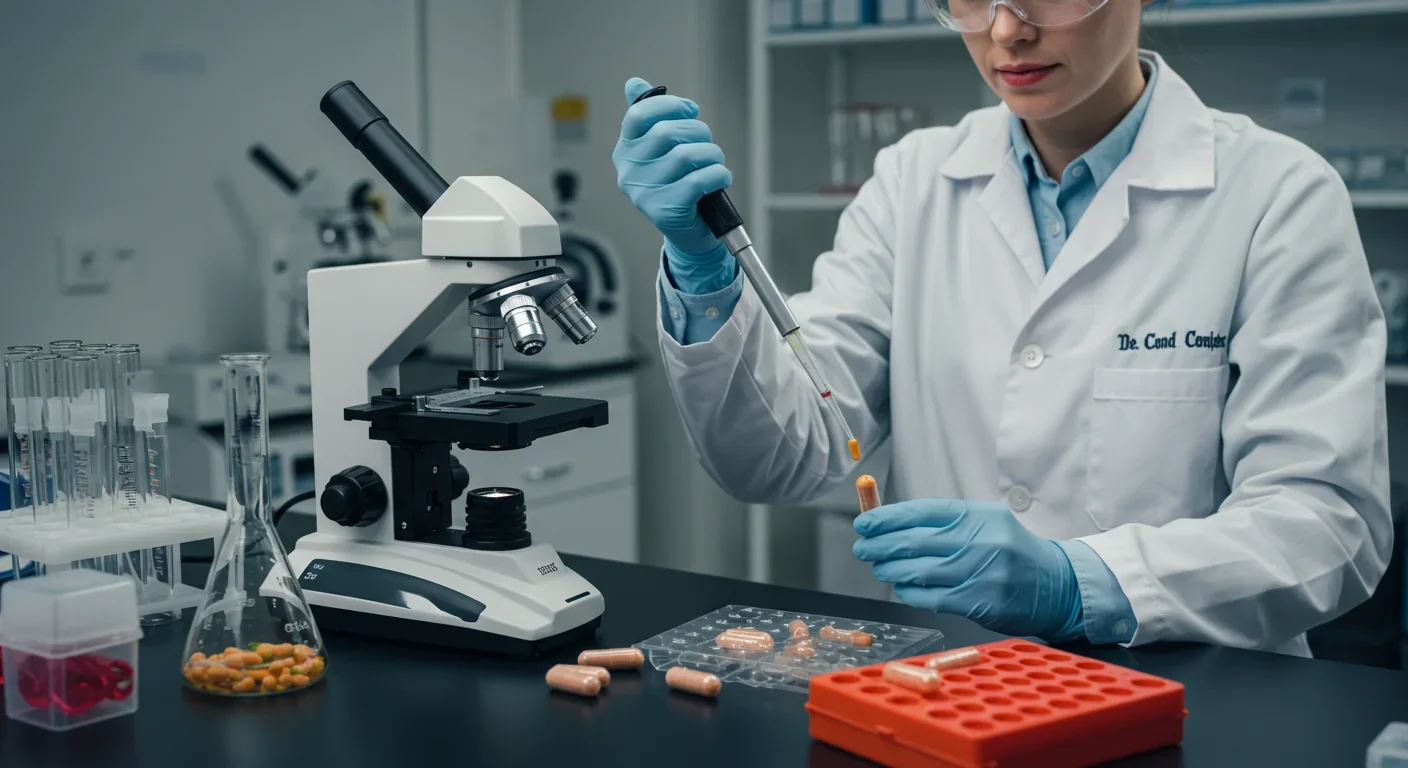Lipid Raft Disruption: The Hidden Driver of Disease

TL;DR: Scientists are revolutionizing gut health by identifying 'keystone' bacteria—crucial microbes that hold entire microbial ecosystems together. By engineering and reintroducing these missing bacterial linchpins, researchers can transform dysfunctional microbiomes into healthy ones, opening new treatments for diseases from IBS to depression.

Within the next decade, your doctor might prescribe not a probiotic blend of 20 random bacterial strains, but a single, precisely engineered microbe. That's because scientists are discovering what ecologists have known for years: not all species are created equal. Just as wolves transformed Yellowstone's entire ecosystem, a handful of "keystone" bacteria might be the difference between a healthy gut and one spiraling toward disease.
The breakthrough isn't just theoretical. Researchers have identified specific bacterial species that, when missing, cause entire microbial communities to collapse—and when reintroduced, restore balance to chaotic gut ecosystems. This isn't your grandmother's yogurt; it's precision medicine that could revolutionize how we treat everything from inflammatory bowel disease to depression.
The concept of keystone species comes straight from ecology. When marine biologist Robert Paine removed starfish from tide pools in 1969, the entire ecosystem collapsed. The starfish weren't the most abundant species, but they held everything together. Remove them, and diversity plummeted.
Scientists are now discovering the gut works the same way. Your microbiome contains trillions of bacteria representing thousands of species, but research published in 2023 shows that only a small fraction truly matter. These keystone species don't dominate by numbers—they dominate by influence.
Take Faecalibacterium prausnitzii, one of the most studied keystone candidates. This bacterium typically makes up about 5% of a healthy gut microbiome, yet its absence correlates with inflammatory bowel disease, obesity, diabetes, and even mental health disorders. It's the gut's equivalent of a social connector at a party—not the loudest person in the room, but the one holding disparate groups together.
The starfish comparison isn't just poetic. Like Paine's tide pools, when keystone gut bacteria disappear, what's left isn't a slightly different ecosystem. It's a fundamentally broken one. Species diversity crashes. Harmful bacteria proliferate. The gut lining becomes inflamed. The immune system goes haywire.
Here's where it gets fascinating: identifying keystone species in an ecosystem containing thousands of microbial species isn't like finding a needle in a haystack. It's like finding a specific needle in a haystack made entirely of needles, where most needles look identical under a microscope.
Traditional methods relied on abundance and prevalence. If a bacterium showed up frequently across healthy people, researchers figured it mattered. But that approach missed keystones that are influential rather than numerous. A machine-learning framework developed at Stanford changed the game by analyzing microbial networks—who interacts with whom, who feeds whom, who produces metabolites that others depend on.
The computational approach treats the microbiome like a social network. Using network topology analysis, scientists map connections between bacterial species, identifying those with the most influential positions. Some bacteria emerge as "hubs" with many direct connections. Others function as "bridges" connecting otherwise separate microbial communities.
The gold standard combines computational prediction with experimental validation. Researchers build microbial communities in the lab, deliberately remove suspected keystone species, and watch what happens. If the community collapses or shifts dramatically, they've found a keystone. If nothing much changes, back to the drawing board.
This approach has revealed surprising keystones. Akkermansia muciniphila, a mucus-degrading bacterium that strengthens the gut lining, shows up in networks as a critical bridge species. Remove it, and the gut barrier weakens, allowing inflammatory molecules to leak into the bloodstream.
Understanding which bacteria matter is one thing. Getting them back into dysfunctional guts is another challenge entirely.
The crudest approach—fecal microbiota transplantation (FMT)—works spectacularly for certain conditions like recurrent C. difficile infections, with cure rates exceeding 90%. But it's essentially an ecological shotgun blast: transfer everything from a healthy person's gut and hope the keystone species take hold. It's effective but imprecise, and it carries risks.
Enter synthetic biology. Researchers are now engineering keystone bacteria with enhanced capabilities. Scientists at MIT and other institutions are modifying F. prausnitzii to produce higher levels of butyrate, an anti-inflammatory compound that feeds gut lining cells. Others are engineering Akkermansia strains that colonize more effectively.
The engineering goes beyond simple genetic modifications. Researchers are creating "designer consortia"—carefully selected groups of 5-10 bacterial species that work synergistically. One might produce a nutrient that feeds another. A third might suppress pathogens that would otherwise attack the group. Together, they're more robust than any single species alone.

The delivery mechanisms matter too. Stomach acid kills most bacteria before they reach the colon. Scientists have developed acid-resistant capsules, freeze-dried formulations that survive digestion, and even bacteria engineered to form protective spores until they reach their destination.
Not all healthy guts are equally therapeutic. When researchers analyzed FMT outcomes, they discovered something peculiar: certain donors produced dramatically better results than others. Some "super-donors" achieved success rates above 90%, while standard donors hovered around 70%.
What made super-donors special? Their microbiomes contained higher levels of keystone species, particularly F. prausnitzii and Akkermansia. But it wasn't just abundance—their keystone bacteria seemed more effective at colonizing and persisting in recipient guts.
This discovery sparked a race to identify and isolate super-donor strains. Companies are now banking these exceptional bacterial lineages, creating living libraries of therapeutic microbes. Think of it as precision medicine meets ecology: instead of generic bacteria, you receive the specific strains proven most effective.
The implications are profound. If researchers can identify what makes a super-donor strain superior—perhaps specific genes that enhance colonization or produce particularly potent metabolites—they can engineer those traits into therapeutic bacteria. The future might involve not finding super-donors but creating them.
The technology exists. The question is whether it works in real patients with real diseases in real-world conditions.
Clinical trials are providing promising answers. A 2025 study on inflammatory bowel disease showed that targeted keystone restoration reduced inflammation markers by 40% compared to placebo. Patients receiving engineered F. prausnitzii reported fewer flare-ups and improved quality of life.
Obesity trials tell a similar story. When researchers transplanted gut microbiota from lean donors to obese recipients, some recipients experienced metabolic improvements—but only those whose microbiomes successfully incorporated keystone species associated with metabolic health. Simply transferring bacteria wasn't enough; the keystones had to establish and persist.
The mental health connection is perhaps most intriguing. The gut-brain axis isn't New Age mysticism; it's neuroscience. Gut bacteria produce neurotransmitter precursors, inflammatory molecules that affect brain function, and metabolites that influence the vagus nerve. Studies show that specific keystone bacteria correlate with reduced anxiety and depression symptoms.
But—and this is crucial—the same keystone species doesn't work for everyone. Your microbiome is shaped by genetics, diet, geography, medications, and a lifetime of environmental exposures. A keystone species that thrives in one person's gut might fail to colonize another's.
This is where precision medicine gets complicated. Unlike a pill that delivers the same dose to everyone, a bacterial therapeutic must survive, colonize, and integrate into a complex existing ecosystem. It's less like prescribing medication and more like introducing wolves to a national park: success depends on whether the ecosystem can support them.
AI and machine learning are becoming essential tools. Researchers feed algorithms data on thousands of microbiomes, linking bacterial compositions to health outcomes. The AI identifies patterns humans can't spot: which combinations of existing bacteria predict successful keystone colonization, which metabolic pathways need to be active, which dietary components enhance bacterial survival.
The goal is a diagnostic framework that analyzes your current microbiome and predicts which keystone interventions will work. Before prescribing Akkermansia, your doctor would verify your gut pH, available nutrients, and existing microbial composition create conditions for success. If not, you'd receive prebiotics—food for beneficial bacteria—to prepare the terrain first.
Companies are already developing at-home microbiome tests that go beyond listing bacterial abundances. They map ecological networks, identify missing keystones, and recommend personalized interventions. Some services even cultivate bacteria from your own gut, selecting the healthiest strains from your personal ecosystem and growing them for reintroduction.
Manipulating complex ecosystems carries risks. Ecologists learned this the hard way: introducing non-native species to solve one problem often creates unexpected others. Cane toads in Australia, kudzu in the American South—well-intentioned interventions gone wrong.
Could engineered gut bacteria become the cane toads of the microbiome world? The FDA is taking the question seriously. Unlike drugs that are metabolized and eliminated, live bacteria persist, evolve, and spread. A bacterial therapeutic could theoretically escape the gut, transfer genes to other bacteria, or evolve in unexpected ways.
Research shows most engineered gut bacteria don't survive long-term without continued supplementation, which is actually a safety feature. They're like garden plants that require constant watering—beneficial while maintained, but they won't overrun the ecosystem.
More concerning is horizontal gene transfer: bacteria swapping genetic material with neighbors. If you engineer a bacterium with antibiotic resistance genes (a common lab tool), could those genes spread to pathogens? Researchers are addressing this by using "genetic safeguards"—engineered dependencies that prevent bacteria from surviving outside specific conditions.
Then there's individual variability. A therapeutic bacterium perfectly safe for 99% of people might trigger problems in someone with a rare genetic condition or unusual microbiome composition. Early trials screen participants carefully, but widespread use means encountering edge cases.

While rigorous clinical trials advance slowly, the commercial microbiome space is exploding. A bewildering array of products claims to restore keystone species: prebiotics that supposedly feed them, postbiotics that contain their beneficial metabolites, and probiotics containing the actual bacteria.
The quality varies wildly. Some products contain dead bacteria or strains that don't survive stomach acid. Others have insufficient doses—you need billions of bacteria to colonize effectively, not the millions in some supplements. Studies analyzing commercial probiotics found many don't contain the species listed on labels.
The evidence base is equally uneven. While companies cite studies showing their specific strains' effectiveness, many studies are small, short-term, or funded by the companies themselves. Independent replication is rare. Positive results get publicized; negative results disappear into file drawers.
This doesn't mean all commercial products are useless. Some companies are conducting legitimate research, publishing peer-reviewed studies, and pursuing FDA approval for specific medical claims. But consumers need to distinguish between evidence-based therapeutics and overmarketed snake oil.
The trajectory is clear: from generic probiotics to precision microbiome medicine. Within ten years, expect to see FDA-approved bacterial therapeutics for specific conditions—not just "gut health" but targeted treatments for Crohn's disease, ulcerative colitis, metabolic syndrome, maybe even depression and anxiety.
The technology will likely follow a tiered approach. First-line interventions might involve simple, well-characterized keystone bacteria shown safe across diverse populations. If those don't work, you'd progress to personalized formulations based on your microbiome profile. For complex cases, fully custom bacterial consortia designed specifically for your gut ecosystem.
Synthetic biology advances will enable increasingly sophisticated bacterial engineering. Imagine bacteria programmed to sense inflammation and respond by producing anti-inflammatory compounds exactly when and where needed. Or bacteria designed to colonize temporarily, deliver a therapeutic payload, then gracefully exit the ecosystem.
The research is even exploring engineered bacteria as disease detectors. Because gut microbiome changes often precede clinical symptoms, bacteria could be designed to produce detectable signals when they encounter early disease markers. Your weekly stool sample would be analyzed not by a lab but by engineered bacteria that "report" on your gut health.
Here's the uncomfortable truth: precision medicine tends to be expensive medicine. Personalized microbiome analysis, custom bacterial formulations, and sophisticated therapeutic monitoring won't come cheap initially. Will this widen health disparities, making cutting-edge gut health treatments available only to wealthy populations?
Global access represents another challenge. Much microbiome research focuses on Western populations with Western diets and disease patterns. Will keystones identified in American or European studies work for populations in Asia, Africa, or South America with radically different baseline microbiomes?
Some researchers are addressing this by studying microbiomes globally, recognizing that keystone species might vary by population. A keystone in Tokyo might differ from one in Lagos or São Paulo. True precision medicine means understanding local ecological contexts, not imposing one-size-fits-all solutions.
Cost could decrease rapidly as technology scales. Bacterial cultivation is cheaper than pharmaceutical manufacturing. Once therapeutic strains are identified and production optimized, manufacturing costs might be lower than traditional drugs. The bigger expense is the diagnostic infrastructure—sequencing microbiomes, analyzing ecological networks, personalizing recommendations.
The keystone species framework represents a philosophical shift in how we think about our bodies. We're not individuals but ecosystems, our health depending not just on human cells but on trillions of microbial partners.
This realization is humbling. When antibiotics disrupt your microbiome, you're not just losing bacteria—you're potentially collapsing an ecosystem that took years to establish. When chronic stress alters gut bacteria, the effects ripple through your immune system, metabolism, and even brain function.
But it's also empowering. If health depends on keystone species, we can potentially identify and restore them. The body's ecosystems, like natural ones, have resilience if we support the right species. This isn't about eliminating all "bad" bacteria but about ensuring the good ones—especially the keystones—can thrive.
The practical implications are emerging. Doctors are beginning to consider microbiome effects before prescribing broad-spectrum antibiotics. Nutritionists are recommending foods not just for human nutrition but to feed beneficial bacteria. Research shows that dietary choices profoundly affect which bacteria thrive, with fiber-rich diets supporting keystone species like F. prausnitzii.
We're still in the early days. Current research has identified perhaps a dozen strong keystone candidates, but the gut contains thousands of species. Many keystones remain undiscovered, their roles in health and disease unknown.
The next decade will bring breakthroughs in understanding microbial interactions. Why do certain bacteria cooperate while others compete? How do keystone species maintain their influence? Can we predict ecological stability or instability in individual microbiomes?
Technology advances will accelerate progress. Metagenomics—sequencing all genes in a microbiome sample—reveals not just which species are present but what they're doing metabolically. Combined with AI, this creates unprecedented ability to understand gut ecosystems in real-time.
The biggest questions remain unanswered. Can we truly engineer stable, healthy microbiomes, or are we oversimplifying fantastically complex systems? Will personalized bacterial therapeutics fulfill their promise, or will individual variability prove an insurmountable barrier? How do we balance innovation with safety as we develop living therapeutics that persist and evolve?
What's certain is that the keystone species concept has transformed microbiome science from a cataloging exercise—listing which bacteria are present—to an ecological one focused on function and interaction. The question isn't just who's in your gut, but what they're doing and how they're working together.
Your gut health might not depend on having every bacterial species, or even the most species. It might depend on having the right ones—the keystones that hold everything else together. Scientists are learning to identify them, cultivate them, engineer them, and prescribe them. What happens next could redefine medicine itself, shifting from fighting disease to cultivating health at the ecosystem level.
The revolution won't happen overnight. But years from now, you might look back at today's generic probiotics the way we now view early antibiotics—crude but groundbreaking first steps toward something far more sophisticated. The keystone species approach isn't just better microbiome medicine. It's the beginning of truly ecological medicine, treating human bodies as the complex, interconnected ecosystems they've always been.

Fast Radio Bursts—millisecond flashes from distant galaxies releasing more energy than the Sun in days—have evolved from cosmic oddities into powerful tools. Advanced telescopes like CHIME now detect dozens weekly, tracing origins to specific galaxies and even individual stars. Magnetars, ultra-magnetized neutron stars, are confirmed sources, yet mysteries abound: repeaters in dead galaxies, second-scale periodicities, and absence of X-ray counterparts. FRBs now map invisible baryons, measure...

Scientists are revolutionizing gut health by identifying 'keystone' bacteria—crucial microbes that hold entire microbial ecosystems together. By engineering and reintroducing these missing bacterial linchpins, researchers can transform dysfunctional microbiomes into healthy ones, opening new treatments for diseases from IBS to depression.

Marine permaculture—cultivating kelp forests using wave-powered pumps and floating platforms—could sequester carbon 20 times faster than terrestrial forests while creating millions of jobs, feeding coastal communities, and restoring ocean ecosystems. Despite kelp's $500 billion in annual ecosystem services, fewer than 2% of global kelp forests have high-level protection, and over half have vanished in 50 years. Real-world projects in Japan, Chile, the U.S., and Europe demonstrate economic via...

Our attraction to impractical partners stems from evolutionary signals, attachment patterns formed in childhood, and modern status pressures. Understanding these forces helps us make conscious choices aligned with long-term happiness rather than hardwired instincts.

Crows and other corvids bring gifts to humans who feed them, revealing sophisticated social intelligence comparable to primates. This reciprocal exchange behavior demonstrates theory of mind, facial recognition, and long-term memory.

Cryptocurrency has become a revolutionary tool empowering dissidents in authoritarian states to bypass financial surveillance and asset freezes, while simultaneously enabling sanctioned regimes to evade international pressure through parallel financial systems.

Blockchain-based social networks like Bluesky, Mastodon, and Lens Protocol are growing rapidly, offering user data ownership and censorship resistance. While they won't immediately replace Facebook or Twitter, their 51% annual growth rate and new economic models could force Big Tech to fundamentally change how social media works.